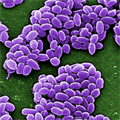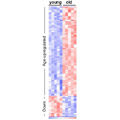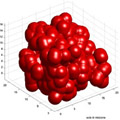IN THIS ISSUE .
. .
December 17, 2008
- Holiday Images: Genetic Mismatch
- Baking Soda Ingredient Makes Anthrax Deadly
- Basic Research Ages Well
- Modeling Bloodstream Infections
- Fertility Trait Determined by piRNAs
Check out the Biomedical Beat Cool Image Gallery.
Got research news to share? E-mail us at info@nigms.nih.gov.
To change your subscription options or unsubscribe, visit the Biomedical Beat subscription page on the NIH LISTSERV Web site.
![]() Subscribe to the RSS version of Biomedical Beat by selecting this
XML link and following your news reader's instructions
for adding a feed.
Subscribe to the RSS version of Biomedical Beat by selecting this
XML link and following your news reader's instructions
for adding a feed.
The National Institute of General Medical Sciences (NIGMS),
one of the National Institutes of Health, supports all research
featured in this digest. Although only the lead scientists
are named, coworkers and other collaborators also contributed
to the findings. To read additional news items, visit NIGMS
News. To check out free NIGMS publications, go to
the order form.
Holiday Images: Genetic Mismatch
High res. image (JPEG, 131 KB)
Like bright berries on a holly bush, proteins (red) attach to chromosomes being pulled apart by microtubules (green). Hover over the image to the next slide, though, and our perfect holiday image blurs. That’s because of mutations in an enzyme called BubR1. Researchers have found that BubR1, which helps move chromosomes into new daughter cells, undergoes distinct chemical changes that may turn its enzymatic activity on or off. Disrupting one of these changes can cause improper chromosome segregation. Because such mismatching is a hallmark of almost all cancers, the work may offer a new lead for cancer research. Courtesy of cell biologist Haomin Huang, Fox Chase Cancer Center.
NIH’s National Cancer Institute also supported this work.
Full story
Article abstract (from the November 17 issue of the Journal of Cell Biology)
Baking Soda Ingredient Makes Anthrax Deadly

The spores of anthrax-causing bacteria (purple) can live dormant for many years. Courtesy of Janice Haney Carr, CDC.
High res. image (JPEG, 340 KB)
Bicarbonate, the active ingredient in baking soda, doesn’t just make muffins rise—it also activates anthrax toxin. This discovery comes from the lab of molecular microbiologist Marta Perego at The Scripps Research Institute. Her team revealed that Bacillus anthracis, the bacterium that causes anthrax, starts production of its deadly toxin only after sensing bicarbonate, a chemical found throughout the human body. Researchers knew that the chemical was involved in many diseases, but hadn’t yet confirmed its leading role. This finding may point to new treatment strategies for anthrax and other bacterial diseases like cholera, strep throat, and food poisoning.
NIH’s National Institute of Allergy and Infectious Diseases also supported this work.
Full story
Perego lab
Article abstract (from the November 21 issue of PLoS Pathogens)
Basic Research Ages Well

Activity readout of sirtuin-controlled genes (red, low; blue, high) showing major differences between young and old mice. Courtesy of Philipp Oberdoerffer and Tom Prolla.
High res. image
(56 KB JPEG)
Scientists have found new clues about what causes aging in mammals. Years ago, Harvard Medical School pathologist David Sinclair learned that the gene sirtuin prevents “aging” in yeast cells because it serves the dual role of controlling gene activity and repairing broken DNA. The accumulation of DNA damage is a feature of growing old. Now, Sinclair and Harvard molecular biologist Ralph Scully have confirmed that sirtuin control is at work in mice, mammals like us. In time, increasing the supply of sirtuins in cells may be a useful therapeutic strategy for aging-associated disorders.
NIH's National Institute on Aging and National Institute of Neurological Disorders and Stroke also supported this work.
Full story
Sinclair lab
Scully lab
Article abstract (from the November 28 issue of Cell)
Modeling Bloodstream Infections

A computer model of a small aggregate of bacteria growing in the bloodstream. Courtesy of John Younger and David Bortz.
High res. image
(152 KB JPEG)
Each year, hundreds of people with bacterial bloodstream infections walk into John Younger’s emergency department at the University of Michigan. To advance research on these infections and their treatment, Younger developed a mathematical model and experiments that examine the physical rules governing bacteria in the bloodstream. The work showed that bacteria spread in just minutes to organs, where they are killed by our natural defenses at different rates. The model also predicted the survival of mice that had the infection and compromised immune systems. The work, though preliminary, represents a new avenue to studying infections like bacteremia and sepsis.
Full story
Younger lab
Article abstract (from the November issue of Shock)
Fertility Trait Determined by piRNAs

Fly ovary showing the I-lelement transposon (green) in a developing oocyte. Surrounding nurse and epithelial cell nuclei are also shown (blue). Courtesy of Gregory Hannon.
High res. image
(68 KB JPEG)
We usually think of biological traits as stemming from the DNA sequence spelled out in genes, but a new study has revealed that fertility in flies depends on another, maternally inherited factor. Molecular biologist Gregory Hannon of the Cold Spring Harbor Laboratory found in females that a type of small RNA called piRNA quells the damaging effects of a genetic element called a transposon. Without piRNAs, transposons wreak havoc on the genome of egg cells and make fly progeny sterile. The work raises the intriguing possibility that small RNA molecules help transmit additional traits in flies and perhaps in other organisms.
NIH's Eunice Kennedy Shriver National Institute of Child Health and Human Development also supported this work.
Full story
Hannon lab
Article abstract (from the November 28 issue of Science)

